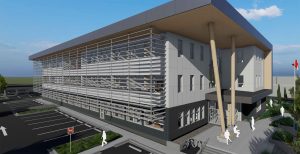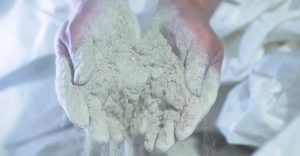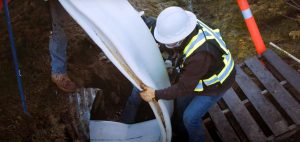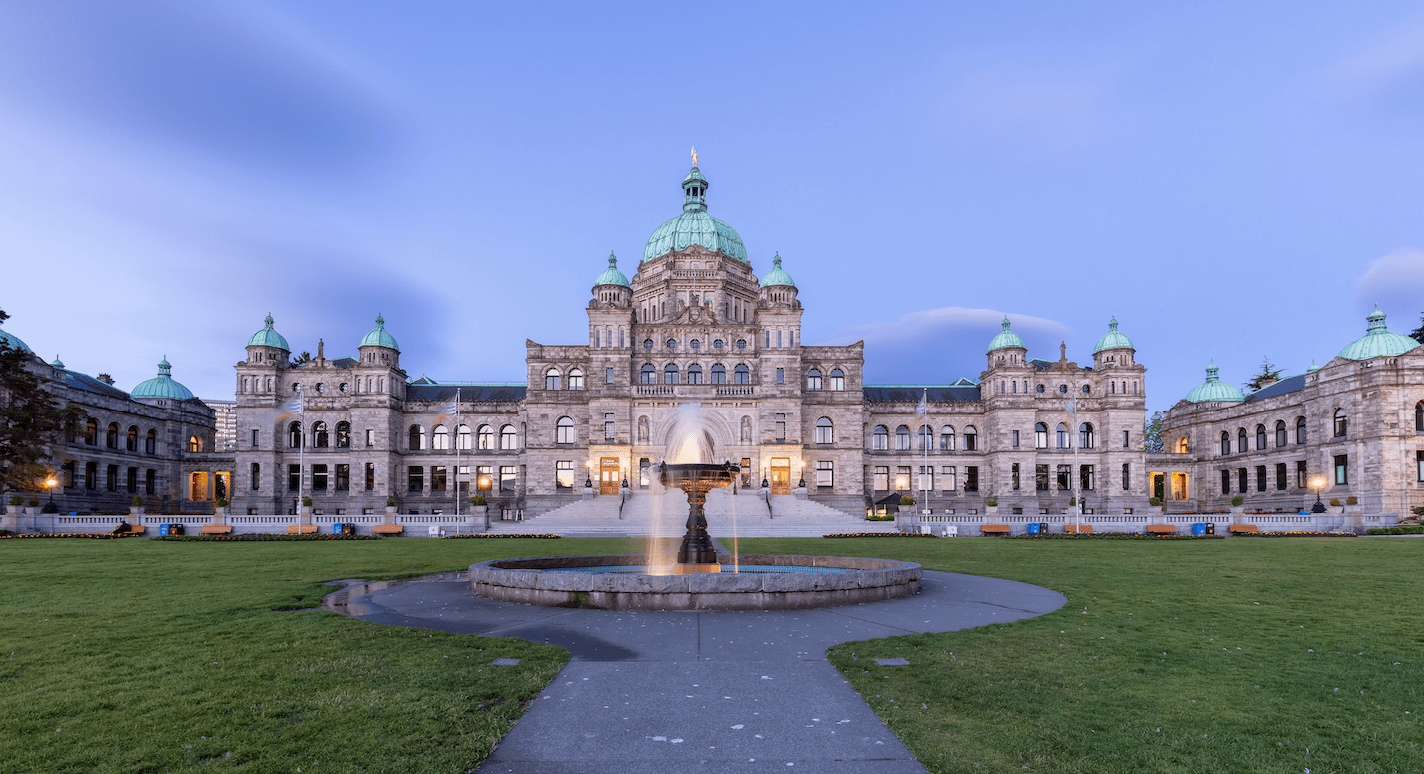Green Construction Bolstered By Industry Advancements And Provincial Investments

Affordable housing provider Pacifica Housing is one of the largest builder-operators of below-market homes in the Capital Region, with state-of-the-art projects in planning like the Burnside School Affordable Housing development earmarked for Cecelia Road (pictured). Pacifica has secured $230,000 from the province’s CleanBC Building Innovation Fund for fuel-switching measures and structure envelope upgrades at one of its Victoria-based multi-unit residential buildings. © Pacifica Housing
By Mike Kozakowski, of Victoria, BC-based Citified Media.
BRITISH COLUMBIA – Innovation and technological improvements among construction industry stalwarts are helping deliver a more efficient, environmentally sustainable and economically competitive generation of buildings and infrastructure projects across Vancouver Island, while provincial dollars are helping showcase made-in-BC initiatives to broader markets.
The provincial government, through the CleanBC Building Innovation Fund has earmarked nearly $10 million for 21 low-carbon building solutions throughout British Columbia, including a $230,000 investment towards Pacifica Housing’s fuel-switching measures and structure envelope upgrades at one of its Victoria-based multi-unit residential buildings. The changes, according to proponents, could yield an 80 per cent or greater reduction in greenhouse gas emissions and their successful adoption likely to set the stage for rapid uptake of similar programs.
Additional monies were awarded to concepts like testing and design certification of FPInnovations’ 3D-printed high-quality, low-cost and energy-efficient homes utilizing residual wood fibres in lieu of traditional materials, the City of Fort St. John’s net-zero energy-ready RCMP detachment, and StructureCraft Ltd.’s software platform to assist with the design, engineering, fabricating and installation of mass timber structures. Financial awards totalled $450,000, $100,000 and $380,000, respectively, among this trio of the 21 chosen applicants.

A rendering of the City of Fort St. John’s net-zero energy-ready RCMP detachment, which received a $100,000 provincial contribution under the CleanBC Building Innovation Fund from the province for the state-of-the-art facility. © City of Fort St. John
“These projects are great examples of how homegrown innovation and technology are putting us on the path to a cleaner, better future,” said Bruce Ralston, Minister of Energy, Mines and Low Carbon Innovation. “Through the Building Innovation Fund, we are investing in projects that showcase British Columbian expertise, reduce pollution, increase energy efficiency and stimulate local economies. By using clean energy more efficiently in our buildings, we’re helping people reduce energy costs, mitigate climate impacts, and improve air quality.”

Nexiite, a powdered material from Nexii similar to dry concrete, is as strong as concrete but made with what the company calls “greener materials.” ©Nexii Building Solutions
On the Island, emerging technologies already in use in other regions are quickly gaining local market penetration thanks to a growing number of firms helping change the way builders and municipal governments solve familiar issues.
As the first company in western Canada to offer a revolutionary method of modernizing or repairing storm and sewer culverts, Parksville’s Leuco Construction brands its new Thermoform PVC Fold and Form service as a cost-cutting effective alternative to open-cut trench excavations.

Leuco Construction crews work at installing a Thermoform PVC Fold and Form culvert liner. Leuco’s unique culvert rehabilitation service saves time and money, and is an environmentally friendly alternative to traditional culvert repair or replacement options. © Leuco Construction
“Trenchless rehabilitation has been around for many years, but PVC lining is a much newer technology, especially on the west coast,” says William Cottrell, President of Leuco Construction.
“The technology avoids excavation, removal of existing piping, extensive utility shutdowns, or public disruptions. There are also no hazardous water-soluble chemicals within the material, no chemical reactions required for it to work, no volatile monomers such as styrene, no noxious vapours to pollute the air and no leaching.”
Cottrell estimates several kilometers-worth of underground utility and stormwater culverts on Vancouver Island will require replacement over the next decade that could benefit from Thermoform, particularly in urbanized areas with high traffic loads.
Victoria’s West Coast Waterproofing (WCW) is pioneering the use of Polyurea as an industrial waterproofing process capable of adapting to a wide variety of situations requiring protection from water exposure or penetration.
Through the use of Polyurea, a sprayable elastomer, WCW is able to avoid the complexities of open flame torch-on waterproof membrane installation to protect environments like green roofs, parkades, concrete decks, balconies and walkways in less time, yet within the same budget as traditional options.

Nanaimo’s upcoming nine-storey Courtyard by Marriott Nanaimo will utilize 140 exterior structural panels developed by Nexii. Able to fit together like jigsaw puzzles, Nexii’s panels improve a building’s energy efficiency and significantly lower energy costs for ongoing building operation, according to the company. © Nexii Building Solutions
WCW promotes Polyurea as fast applying, trafficable within minutes, extremely durable and its use negates the need for carbon emissions during installation. The firm estimates it can handle 5,000 square feet of coverage per day.
In Squamish, Nexii Building Solutions is operating at-capacity to deliver its made-in-BC environmentally-friendly building technologies. Demand, Nexii says, is so strong that a 150,000 square foot production plant is now targeted for Vancouver Island.
Nexii has certified Alexzi Building Solutions to produce its near-zero waste precision-designed, pre-manufactured Nexii panels in a purpose-built factory that is in its final stages of site procurement. Nexii reports that its state-of-the-art panels significantly reduce the climate impact of construction and slash onsite build times by up to 75 per cent without sacrificing water or fire resistance, or earthquake resiliency. Such efficiency, according to Anne Tanner, Executive Vice President of Royal LePage Commercial’s leasing and sales division (assisting Alexzi’s site selection), can yield significant budget savings critical to providing attainable housing in southwestern BC.
“As Nexii’s manufacturing partner, accessing leading green construction technology and products, Alexzi is at the forefront of breakthrough 21st century building materials with a proven track record in British Columbia and expanding in jurisdictions throughout North America,” Tanner said.
Created by construction industry innovators Michael and Ben Dombowsky, Nexii was born out of the energy crisis of the 1970s when research and testing first began at the hands of the brothers in pursuit of efficient and sustainable methods of building. Today’s material science advancements coupled with market demand for innovative alternatives to steel and concrete have created a niche for Nexii’s solutions and an impetus for expanding its network of certified manufacturers to markets across North America.


